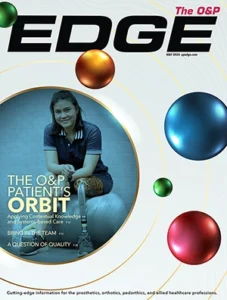ORIGINAL POST
We are being sent a patient with 48″ waist but she is 5 feet tall. What have
you had success with to control spinal flexion at T-12/L-1?
I’ll post responses. Thanks, Randy McFarland, CPO Fullerton, CA
RESPONSES
With these kinds of proportions, the only thing I have ever had reasonable
success with was a custom TLSO. At the requests of physicians, I have spent
many hours trying to modify and contour CASH orthoses, Jewetts, and various
devices with spinal sticks, but none that I have found are really suited for
this, and they don’t tend to stay in place. There are some, like the
Cybertech cruciform or the Otto Bock Dorso Arexa, that can deal with the
circumference (I am assuming that the waist of this patient is her largest
circumference, or close to it), but the anterior contour rarely works, and
even when it does, there is usually just too much moveable tissue to
maintain alignment. Although they require a bit of tweaking for these
shapes (mostly height problems), Jewetts tend to stay in place decently, but
with the usual abdominal contours of patients like this, it is tough to
avoid edge pressures from the bars.
I recently had this same issue and I used the relatively new aspen summit
456. The back section is adjustable in height. Nice brace.
A modified spinal hyperextension orthosis? You would have to shorten the
lateral uprights.
I use a CASH but widen the abdominal pad to lessen the penetration into the
abdominal tissues.
Becker makes custom Jewet’s. I have used them with OK results. I prefer a
custom TLSO though.
You could try the Florida Brace JewettR J-45 X-Large X-Short Contraflexion
Brace designed to inhibit LS flexion. It is not a true hyperextension like
the J-35. You can check on Florida brace website for the J-45 Brace Size
Chart to confirm height, chest and waist circumference measurements for your
patient. This is available through SPS, Cascade, PEL or direct from FBC.
My wife is a PT who specializes in osteoporosis. We constantly are
collaborating on the best orthosis to accommodate as much extension as
possible. Certainly, all those mentioned in your responses I am familiar
with and have used.
The only orthosis we are aware of that has evidence based success in
accomplishing extension is the Spinomed by Medi. (They have just launched
their most recent edition which is easier to don than the previous. It is
called Spinomed IV. I order it thru SPS, get it more quickly than going thru
Medi)
We are now routinely fitting our osteoporosis/kyphotic patients with this
orthosis with excellent compliance.
Do we still have some of the common fit issues such as migration etc, sure
we do. However, compared to the traditional hyperextension TLSOs, these are
a breath of fresh air.
Now, let me qualify this by saying our success lies in collaboration with
PT. We have protocols we follow that incorporates exercise to make this
thing work. In the years I have been doing orthotics, seldom do I see
success without intervention of other therapeutic interventions.
Note- I ended up fitting her with a spinal extension orthosis on her,
which she refused, then fit her with a prefab. Thoraco lumbar orthosis with
well padded shoulder straps. She left with it, then, after one day she
returned it to our office. Later, her husband came back and picked it up
again. I always let patients know that the orthosis is not intended to hold
their back straight for them. It is to remind them to use their own muscles
to maintain the desired position.




